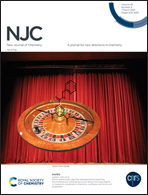Versatile quantitative biopsy: an approach for cost-effective detection of hydrogen peroxide in tissue specimens†
Abstract
Biopsies are widely used by surgeons due to their simplicity and practicality, but without sufficient information on a potential biomarker, it is difficult to achieve the goal of accurate disease diagnosis using this strategy. Furthermore, biomarker analysis needs well-developed techniques that are not suitable for detection in poorly equipped areas or rural countries. Therefore, we report a versatile quantitative biopsy (PEG-b-(PPRLT-g-BPmoc)@Amylose/Glu-PGM) for the quantitative detection of biomarkers cost-effectively. In our proposed method, hydrogen peroxide (H2O2) is chosen as a potential biomarker due to its close association with cancer progression, which was recognized by an amphiphilic polymer, viz. PEG-b-(PPRLT-g-BPmoc), synthesized via the “click” reaction. The polymer can self-assemble into micelles, in which amylose is ensnared. Emergence of H2O2 can activate the micelles and release amylose, which comes into contact with glucoamylase solution added to the sample, leading to the generation of glucose for cost-effective detection by a personal glucose meter (PGM). Through the detection of H2O2 in a tumor mice model at different periods (6–30 days), we observed that the PGM value increased significantly from 12 to 30 days, meaning that as the tumor enlarged, the concentration of H2O2 maintained an upward trend. Moreover, three kinds of actual cancer samples were studied by PGM, and the breast cancer sample presents the highest concentration of H2O2, followed by colon cancer, and cervical cancer shows the lowest concentration of H2O2. Thus, the feasibility is verified by quantitative analysis of the H2O2 concentration in three kinds of actual cancer and different stages of cancer samples. To the best of our knowledge, this is the first example to rationally design a quantification-based biopsy for low-cost identification of disease, which will provide possibilities for developing biomarker-recognition based quantitative biopsies for hospitals in poorly equipped rural areas.



 Please wait while we load your content...
Please wait while we load your content...